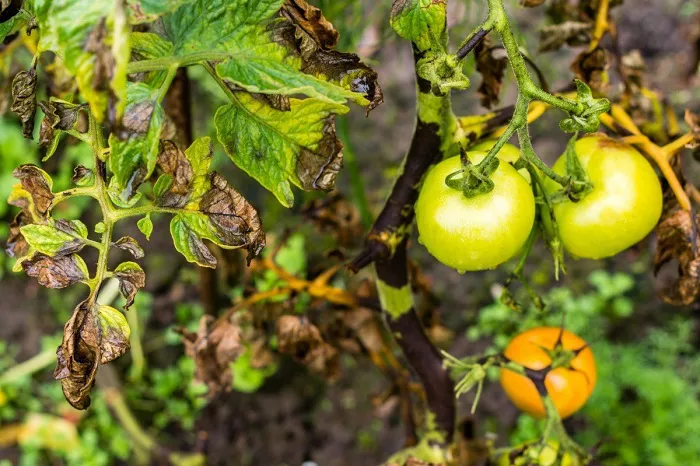Tomatoes are a favorite crop for many home gardeners. They’re easy to grow and produce juicy fruit throughout the season. But sometimes, healthy green leaves start turning brown. This can be frustrating and confusing. Let’s explore the reasons why this happens and how to fix it.
Understanding Browning in Tomato Plants
When tomato leaves or stems turn brown, it usually means something is wrong. It may be caused by pests, disease, poor watering, or nutrient issues. Early detection helps save your plant.
What Are the Signs?
Browning may show up as dry edges, brown spots, or entire leaves changing color. Sometimes the brown areas become crispy or soft. The location and pattern of browning can hint at the cause.
Is It Always a Problem?
Not always. Some browning is natural, especially in older leaves at the bottom. But if the problem spreads fast or affects fruit production, you need to act quickly.
Common Causes of Browning in Tomato Plants
1.Watering Problems
Overwatering: Too much water can cause root rot. This stops roots from taking in oxygen and leads to brown, wilting leaves.
Underwatering: Dry soil leads to dry, brittle leaves. Plants can’t get enough water to stay healthy.
2.Fungal Diseases
Early Blight: Caused by the fungus *Alternaria solani*, this disease causes dark brown spots with yellow halos.
Late Blight: This is more serious. It causes dark brown or black areas and can kill the whole plant.
Septoria Leaf Spot: This fungal disease causes small brown spots with gray centers, usually on lower leaves first.
3.Bacterial Diseases
Bacterial Spot: Leaves develop small, greasy-looking brown spots.
Bacterial Canker: This causes brown leaf edges and streaks on stems. It’s difficult to treat and spreads quickly.
4.Pests
Aphids: These small bugs suck sap from leaves, causing them to curl and brown.
Spider Mites: They leave tiny brown spots and webbing.
Tomato Hornworms: These large caterpillars chew leaves, leaving brown, ragged edges.
5.Nutrient Deficiency
Potassium Deficiency: Causes brown edges on leaves.
Calcium Deficiency: This often shows as blossom-end rot—brown, sunken spots on the bottom of fruit.
Magnesium Deficiency: Leads to browning between the veins of leaves.
6.Sunscald and Heat Stress
When fruits or leaves are exposed to intense sunlight, they may burn and turn brown. Plants may also wilt in high heat, leading to leaf damage.
7.Chemical Damage
Herbicide drift or overuse of pesticides can harm tomato leaves, turning them brown or curled.
How to Prevent Tomato Leaves from Turning Brown
1.Proper Watering
Water deeply and evenly. Avoid letting soil get too wet or too dry. Water at the base of the plant to keep leaves dry.
2.Disease Prevention
- Rotate crops every year.
- Remove infected leaves quickly.
- Use disease-resistant varieties.
- Don’t water from above—wet leaves invite disease.
3.Fertilizer and Soil Health
Test your soil before planting. Use a balanced fertilizer. Add compost to improve soil structure and nutrients.
4.Pest Control
Check plants often for pests. Use neem oil or insecticidal soap if needed. Encourage beneficial insects like ladybugs.
5.Shade and Temperature Management
Use shade cloth on hot days to protect plants from sunburn. Mulch helps keep roots cool and moist.
Diagnosing Problems in Tomato Plants
1.Step-by-Step Guide
- Check the soil—Is it wet or dry?
- Look for patterns—Are spots round? On edges? Bottom or top of plant?
- Inspect for bugs under leaves.
- Review watering and fertilizing habits.
- Compare with photos of common diseases.
2.Use Gardening Journals
Keeping notes on your garden helps you see what works. If a plant gets sick, you can look back at what changed.
Seasonal Factors That Cause Browning
End-of-Season Yellowing and Browning
As tomato plants age, lower leaves naturally turn yellow and brown. This is normal and doesn’t need treatment.
Cold Nights and Temperature Swings
Chilly weather stresses tomato plants. Leaves may turn brown if exposed to frost or big changes in temperature.
When to Remove Brown Leaves
Trimming for Health
If leaves are badly damaged or diseased, remove them. Use clean scissors. This helps the plant focus energy on healthy parts.
When Not to Worry
If only a few bottom leaves are brown, and the rest of the plant looks fine, it’s usually okay to leave them.
Best Practices for Healthy Tomato Plants
- Plant in full sun.
- Use mulch to hold moisture and prevent splashing.
- Prune lower leaves to improve air flow.
- Space plants well apart.
- Support plants with cages or stakes.
Conclusion
Browning in tomato plants can be caused by many things. From pests to poor watering, knowing the signs helps you act early. With care and attention, your plants can stay healthy and productive all season long.
FAQs About Tomato Leaves Turning Brown
Q1: Should I cut off brown leaves from my tomato plant?
Yes, especially if they are diseased or badly damaged. Removing them helps the plant stay healthy.
Q2: Can overwatering cause brown leaves?
Yes. Too much water can lead to root rot and cause leaves to wilt and turn brown.
Q3: How do I tell if it’s a disease or a nutrient problem?
Look at the pattern. Diseases often cause spots or patches. Nutrient problems affect edges or veins. Soil tests help confirm the cause.
Q4: Are brown leaves always a bad sign?
No. Older leaves naturally turn brown. If new growth is green and healthy, there’s usually no problem.


